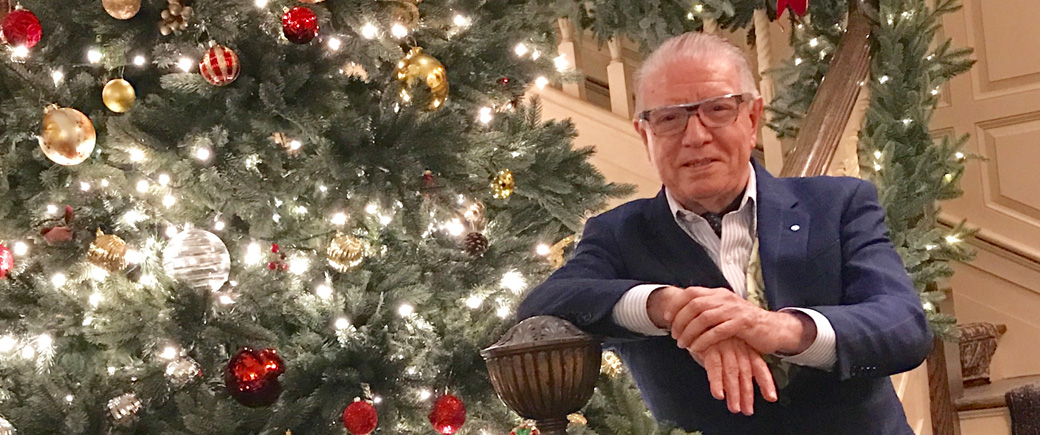Feliz Navidad
A Cuban Émigré Recalls his Childhood Christmases
Abdo Ballester came to this country from Cuba more than 60 years ago and has been the face of the boutique at the Mayflower for more than 25 years, until his recent retirement. He is also the organizer of Summer Solstice for the Washington Art Association. He was a child when he arrived and settled easily into life in America.
“I came to this country in the ’50s,” he explains. “I am the youngest of four and after the revolution my parents sat us down and asked which one of us would like to study abroad. Another plantation owner had sent his children to the United States and my father wanted to do the same.
“I jumped at the opportunity. I was suffocating in a Cuban society where my father was very involved in being part of the upper class and all that goes with it. It becomes a lot of pressure – you have to behave properly. I was 16 years old and just had this idea that I wanted to see the world.”
And, so, he arrived America and never saw his parents again. But the memories of his childhood remain vivid to this day—particularly those centered around the holidays.
He can still remember the excitement of celebrating Christmas as a child in Cuba. It was, as he explains BC “Before Castro.”
“When I was growing up the country was 98 percent Catholic,” Ballester said. “So, you had 11 million Cubans celebrating Christmas. There was an energy and joyfulness that no Cuban can ever forget. My grandparents came from Spain so that was where our traditions originated. Noche Buena, the Good Night, was a very special time for us—the biggest celebration day of the year.”
Unlike, this country, where commercialism reigns and Thanksgiving is sometimes given short shrift to make way for early Christmas campaigns, the Cuban celebration begins on December 24th and carries on for 15 days, ending on January 6th, known as Dia de Reyes, Three Kings Day of the Epiphany. At the sumptuous meal prepared on the first evening, the star attraction was a barbecued pig.
“Aside from the roasted pig at the table we had yucca with garlic mojo, a sauce made with olive oil and lots of garlic and herbs,” Ballester recalls. “The yucca root has no flavor without the sauce. Fried plantains, both green and sweet. The rice with beans was cooked in the belly of the pig. This way it would absorb the flavors—so good! Cuban bread, similar to a French baguette.
“For dessert,” he continued, “We had lots of sweets, a tradition that came to us from Spain: jijona, which is a soft, sweet nougat, made with ground almonds and honey, and turron de alicante, a Spanish hard nougat. We also had grapes and apples and Spanish wine. As children, we were allowed to have a taste for the toast.”
Following the universal Christmas tradition, there was always a tree. It came from the mountains where it was cooler and the trees grown there were healthier.
“My mother loved those bubble lights which I think were popular here in the States in the ’50s and ’60s. She covered our entire tree with them and the house would sparkle with all these lights bubbling up and down. She also had a collection of ornaments, many handmade, and some dating back to her own childhood. Garlands all around and always a star on the top of the tree. It was quite a spectacle.
“After dinner we could hear all the church bells ringing, reminding us that we should be there for midnight mass,” he related. “And we would go as a family. In Washington (CT), where I now live, I can hear the bells from Our Lady of Perpetual Help and it reminds me of those bells pealing in Cuba.”
But there was more to come.
“While Christmas Day was much more subdued, there was a dance on December 31st. But everyone looked forward to January 6th, Dia de Reyes, when gifts were exchanged and we would eat 12 grapes in anticipation of the 12 lucky months ahead of us,” says Ballester. “Everyone would choose a king. I chose Balthazar and would write him a note telling him what I wanted for Christmas. The previous night, before I got into bed, I would go to the yard, cut some grass, tie a piece of rope around it and make a small bundle. Then I would put it beside my bed with some water for the camel Balthazar would be arriving on.
“You can just imagine the excitement when you opened your eyes in the morning to see if the grass and water were gone. If they were, then you knew that Balthazar had come and your wish would be granted. That night there was another big dance to complete the holidays season.”
But presents weren’t the focal point. There would be perhaps one or two very special things that Ballester really wanted.
“Christmas in Cuba is very much about family and food. It isn’t about good behavior to earn presents. It’s about expressing love to family members and enjoying each other and being thankful for what we already had.”
During his years at the Mayflower, Ballester always took charge of the tree. At his own home, he keeps it simple but cherishes the time he will spend with family and friends in Washington, always remembering his happy days in Cuba.

